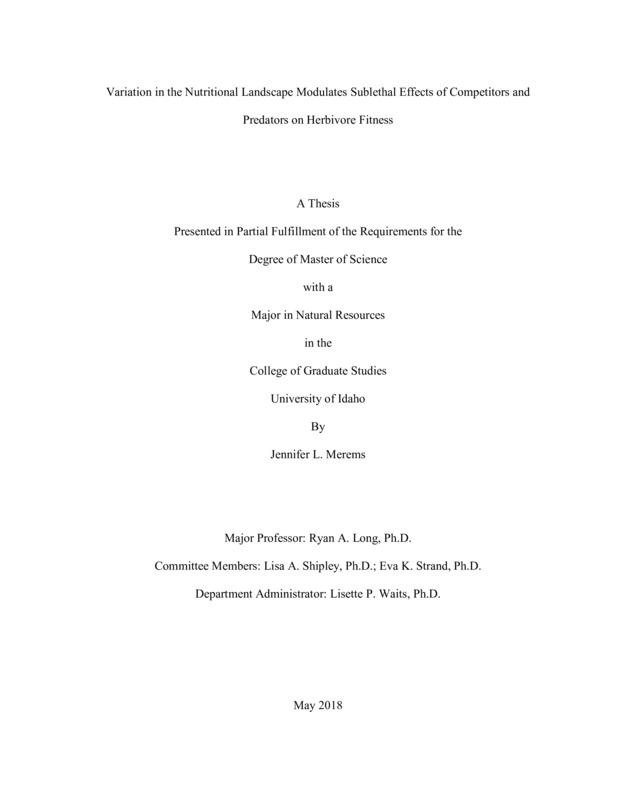Variation in the Nutritional Landscape Modulates Sublethal Effects of Competitors and Predators on Herbivore Fitness
Merems, Jennifer. (2018-05). Variation in the Nutritional Landscape Modulates Sublethal Effects of Competitors and Predators on Herbivore Fitness. Theses and Dissertations Collection, University of Idaho Library Digital Collections. https://www.lib.uidaho.edu/digital/etd/items/merems_idaho_0089n_11343.html
- Title:
- Variation in the Nutritional Landscape Modulates Sublethal Effects of Competitors and Predators on Herbivore Fitness
- Author:
- Merems, Jennifer
- ORCID:
- 0000-0002-8124-0270
- Date:
- 2018-05
- Program:
- Natural Resources
- Subject Category:
- Wildlife conservation; Wildlife management
- Abstract:
-
In heterogeneous landscapes large herbivores employ plastic behavioral strategies to cope with tradeoffs among environmental variables that influence fitness (e.g., forage availability, predation, and competition). Yet how individual responses to such tradeoffs scale up to influence population performance remains uncertain. Similarly, the degree to which sublethal effects of competitors and predators on herbivore fitness are modulated by variation in the nutritional landscape has not been addressed. Over the past several decades, mule deer (Odocoileus hemionus) populations have declined precipitously throughout their historic range in western North America. Competition with elk (Cervus canadensis) and predation by mountain lions (Puma concolor) are thought to have contributed both directly and indirectly to the decline of mule deer, but the mechanisms underpinning those effects have not been clearly established. We sought to understand (a) whether the risk of encountering competitors (elk) or predators (mountain lions) displaced mule deer from the most favorable parts of the nutritional landscape, (b) whether that displacement translated into effects on early winter body condition (and thus, ostensibly, fitness) of mule deer, and (c) whether the indirect effects of interference competition and predation risk on mule deer condition were modulated by plastic behavioral responses to those risks among individual deer.. At the population level mule deer strongly avoided habitats with a high risk of predation, and this behavior was more pronounced during summer than spring. Avoidance of risky habitats also was coincident with either avoidance or indifference to the nutritional landscape during both seasons. Moreover, as risk of predation increased mule deer showed progressively stronger avoidance of the most favorable parts of the nutritional landscape, suggesting that they were forced to make tradeoffs between forage and predation risk. The influence of competition on mule deer behavior was similar in nature but attenuated relative to the effect of predation risk. One apparent consequence of suboptimal use of the nutritional landscape by mule deer was that nutritional condition (measured as percent ingesta-free body fat) was below reported thresholds for maintaining positive population growth. At the individual level, stronger selection for the nutritional landscape during spring, when forage resources were more evenly distributed and the effects of predation risk on behavior were less pronounced, significantly improved nutritional condition in early winter. Our study is among the first to elucidate the nutritional mechanisms underpinning indirect effects of predation risk and competition on a large herbivore, and our results provide important insights into the drivers of mule deer decline in western North America.
- Description:
- masters, M.S., Natural Resources -- University of Idaho - College of Graduate Studies, 2018-05
- Major Professor:
- Long, Ryan A
- Committee:
- Shipley, Lisa A; Strand, Eva K
- Defense Date:
- 2018-05
- Identifier:
- Merems_idaho_0089N_11343
- Type:
- Text
- Format Original:
- Format:
- application/pdf
- Rights:
- In Copyright - Educational Use Permitted. For more information, please contact University of Idaho Library Special Collections and Archives Department at libspec@uidaho.edu.
- Standardized Rights:
- http://rightsstatements.org/vocab/InC-EDU/1.0/

